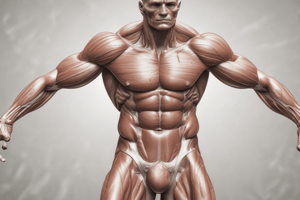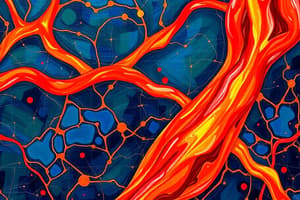Podcast
Questions and Answers
What characteristics differentiate Type 1 muscle fibers from Type 2 muscle fibers?
What characteristics differentiate Type 1 muscle fibers from Type 2 muscle fibers?
- Type 1 are slow twitch and fatigue resistant with high aerobic capacity. (correct)
- Type 1 are faster and have a higher force production capacity.
- Type 1 fibers are larger in diameter than Type 2 fibers.
- Type 1 rely primarily on anaerobic metabolism.
Which staining technique is used to differentiate muscle fibers based on their myosin ATPase activity?
Which staining technique is used to differentiate muscle fibers based on their myosin ATPase activity?
- Immunohistochemistry staining.
- Myosin ATPase staining. (correct)
- Histochemistry staining.
- Biochemical classification.
Which muscle fiber type is primarily utilized during endurance activities such as a marathon?
Which muscle fiber type is primarily utilized during endurance activities such as a marathon?
- Type 2A fibers.
- Type 2X fibers.
- Type 1 fibers. (correct)
- Type 2B fibers.
What is a characteristic feature of Type 2A muscle fibers compared to Type 2X muscle fibers?
What is a characteristic feature of Type 2A muscle fibers compared to Type 2X muscle fibers?
What indicates the correlation between myosin ATPase activity and the speed of muscle fiber contraction?
What indicates the correlation between myosin ATPase activity and the speed of muscle fiber contraction?
Which classification identifies muscle fibers based on their metabolic capacity?
Which classification identifies muscle fibers based on their metabolic capacity?
What is the main functional difference between fast twitch oxidative fibers and fast twitch glycolytic fibers?
What is the main functional difference between fast twitch oxidative fibers and fast twitch glycolytic fibers?
Which type of myosin heavy chain is associated with the fastest muscle fiber type in humans?
Which type of myosin heavy chain is associated with the fastest muscle fiber type in humans?
What happens to the lattice spacing when the muscle shortens during contraction?
What happens to the lattice spacing when the muscle shortens during contraction?
How does an increase in lattice spacing affect the force vector during muscle contraction?
How does an increase in lattice spacing affect the force vector during muscle contraction?
Which statement describes a motor unit?
Which statement describes a motor unit?
What role does acetylcholine play in muscle contraction?
What role does acetylcholine play in muscle contraction?
What happens to the overlap of actin and myosin during muscle lengthening?
What happens to the overlap of actin and myosin during muscle lengthening?
Flashcards are hidden until you start studying
Study Notes
Muscle Fibre Typing
- Muscle fibres can be classified using different methods: myosin ATPase staining, myosin heavy chain identification and biochemical classification
- Initial classification is based on the speed of muscle fibre shortening: fast or slow
- Fast muscles are "white"
- Slow muscles are "red"
- Myosin ATPase activity correlates to speed of shortening, leading to classification of Type 1 (slow) and Type 2 (fast)
Myosin ATPase Staining
- Myosin ATPase rates are 2-3 times greater in fast fibres
- Fibres are separated based on staining intensities due to pH sensitivity
- Originally classified as type 1A, type 2A and type 2B
Myosin Heavy Chain Identification
- Type 1 fibres are stained green
- Type 2 fibres are stained black
- The staining colour is based on the myosin heavy chain isoforms present
- Myosin heavy chains (MHC) are the motor protein of the thick muscle filaments
- Different myosin ATPase based fibres correspond to different myosin heavy chain isoforms (MHC1 and MHC2)
- Each fibre can contain more than one heavy chain isoform - it does not have to be pure MHC1 or MHC2
- Further classified into MHC2A and MHC2B, which is referred to as MHC2X in humans
- Humans have MHC1, MCH2A and MCH2X
Biochemical Classification
- Combines information on fibre myosin ATPase histochemistry and biochemistry of specific enzymes
- The enzymes reflect energy metabolism of the fibre
- Referred to as aerobic/oxidative or anerobic/glycolytic fibres
- Further classified into fast twitch glycolytic, fast twitch oxidative and slow twitch oxidative fibres
Fibre Types
- Type 1: slow twitch, fatigue resistant, high capacity for aerobic energy supply, limited potential for high force production due to low myosin ATPase - examples: endurance events like a marathon and long distance running
- Type 2A and Type 2X: fast twitch, fatigue with low aerobic power, high force production capacity, type 2A fibres have higher aerobic capacity than type 2X fibres - examples: power events like shot put and power lifting
Muscle Structure
- Muscle is composed of bundles of muscle fibers.
- Each muscle fiber contains multiple myofibrils.
- Myofibrils are made up of myofilaments, which are protein filaments responsible for muscle contraction.
- Actin (thin filament) and myosin (thick filament) are the key myofilaments.
Length-Tension Relationship
- Muscle length impacts force production due to changes in the spacing between actin and myosin (lattice spacing).
- As lattice spacing increases (muscle lengthening), the distance between myosin heads and actin binding sites increases, requiring a greater displacement for binding and affecting force vector.
- Shortening a muscle increases actin and myosin overlap, while lengthening decreases overlap.
- Increased sarcomere length decreases lattice spacing.
Skeletal Muscle Motor Unit
- A motor unit is a functional unit composed of a motor neuron and the muscle fibers it innervates.
- Motor unit size affects the precision of movement:
- Smaller motor units with fewer muscle fibers per neuron provide fine control (e.g., eye movements).
- Larger motor units with more muscle fibers per neuron are involved in gross movements (e.g., knee extension).
Neuromuscular Junction
- The neuromuscular junction is the synapse between a motor neuron and a muscle fiber.
- The signal from the motor neuron travels to the axon terminal.
- Acetylcholine, a neurotransmitter, is released from the axon terminal into the synaptic cleft, initiating the signal transmission to the muscle cell.
Sliding Filament Theory
- Muscle contraction occurs through the sliding of actin and myosin filaments.
- Myosin heads bind to actin via cross-bridges, creating the force for filament sliding.
Studying That Suits You
Use AI to generate personalized quizzes and flashcards to suit your learning preferences.




